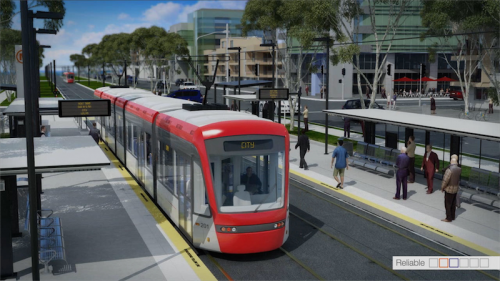 EVERY now and then I’m part of a discussion about the Light Rail project. It usually begins because there’s someone who dislikes it, and says so.
EVERY now and then I’m part of a discussion about the Light Rail project. It usually begins because there’s someone who dislikes it, and says so.
On the whole, everyone else goes quiet, presumably on the principle that polite people don’t discuss politics, religion or sex. But recently I poked my oar in.
“I dunno, really, but isn’t that what governments are for?”Total silence, so I had to try and explain, which goes like this.
Our ACT Government has a fairly limited set of functions to perform, which include providing some services and building infrastructure.
The idea of light rail for Canberra has been about as long as I can remember; it has remained an idea because it is expensive, and once begun it will have to be continued indefinitely to produce scale benefits.
Running a service from Gungahlin to the city will benefit perhaps 10 per cent of our population, though all of us will pay for it.
The real cost of each individual journey will be high. But if the system extends to Tuggeranong, Queanbeyan, Woden, Belconnen and the rest it will in time benefit (in principle) all of us, and the cost of an individual journey will be less.
What is the alternative? Our bus system presently runs at a huge loss anyway, as most bus systems do. In fact, mass transit systems in urban areas need injections of public money to make them viable. The benefit is that the city works as a whole.
Perhaps the Government has come to the view that we have reached “peak oil” and that we need to be using electricity for transport. It may be wrong about that, but no one has good knowledge about the future. Governments are there to make big and important decisions that affect all of us for years and years, and they have to do it with the knowledge they have.
Like everyone else, I have my own views on the growth of car use in the ACT, global warming, peak oil, and the relative attractiveness of buses and light rail. But I have also had some policy experience of the parking problem in Canberra, which is minor in comparison with the traffic congestion of Melbourne or Sydney, but is much worse than it was 20 years ago – let alone 40 years ago, when those of us then residents could reasonably expect to park outside wherever we were going to.
So it seems to me that in the long run more and more of us will choose to travel into the city and to the smaller urban centres by public transport, as parking prices rise and parking availability declines.
Is it too soon to be making such a decision? In retrospect big infrastructure will usually have been cheaper if it had been constructed earlier. And the longer we wait to make such decisions, the more we will find that other decisions have got in the way of the best routes, the best station locations and so on.
The announced cost of the 12km line is said to be “nominal”, at $783 million, and a private consortium is expected to handle it.
Those who have to talk the money try to keep the sum as small as they can, but our general experience is that the final cost will be a lot more – say $1 billion to $1.5 billion. Can the ACT afford it?
Yes, but capital expenditure of that size will rule out other possibilities. Much depends on how much private investment arrives – but then private investors will want substantial guarantees.
Complicated? Yes. Difficult? Yes. That’s why it is a decision for the Government. The Liberal Opposition doesn’t like it, and that is understandable. It needs some sort of stick. However, if it is elected, it will continue with the project, whatever it now says.
The post Aitkin / Why governments keep us on the rails appeared first on Canberra CityNews.
